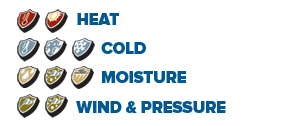WHITE ROOFS PRESENT
SOME GREY AREAS
The environmental benefits of white roofs have made them somewhat trendy. They've become a favored option to mitigate urban heat-island effect, reducing cooling costs, and find a recyclable membrane to create a more sustainable roofing system. These benefits only increase with the life of the roofing system - i.e. the longer the life, the greater the environmental benefits.
A roofing system has several functions including energy management and waterproofing. Design, craftsmanship and choice of materials all contribute to a good roofing system. It's important to be vigilant and recognize that white membrane systems can have variable quality and longevity, and unfortunately, this can't be determined by a cursory inspection of a membrane sample.
Longevity is a key determinant of white roofing performance. Manufacturers use different methods to project the service life of membranes, which typically range from 10 to 40 years.
Sometimes those are projected theoretical estimates. For example, a material that is UV-resistant and will not deteriorate from exposure to UV is assumed to have a projected long life.
Membrane life spans are also estimated based on accelerated aging and accelerated weathering in a laboratory. Environment. These test techniques can be designed and performed by the manufacturer or they can be government approved testing performed in accredited laboratories using regulated standards.
Proven field exposure is also used for estimates. Membranes that have a history of proven longevity also conform to the ASTM (American Society for Testing and Materials) and/or CGSB (Canadian Government Standards Board) standards.
Many white membranes are polymer based, including Thermosets (EPDM and CR) and Thermoplastics (PVC, KEE, TPO and CPE). Yet, these membranes have very different physical and chemical properties.
Some types such as PVC have been available for a long time and are subject to ASTM and CGSB based standards. Others such as TPO are fairly new and are not yet regulated, since ASTM and CGSB standards are still being developed.
Building owners should compare the components of a prospective new roof system against the existing roof system, and ensure that designs for the new system have a higher R-value. Insulation is still the most effective means of energy conservation.
Some manufacturers have changed their formulas repeatedly as deficiencies arise so prospective buyers should ask how long the contemplated membrane has been on the market. They should also check out a recent roof installation to gauge contractors' craftsmanship and competency with the product.
If possible, it can be quite insightful to see an older roof that has reached its predicted service life. This will show how the membrane has aged and other symptoms of wear that can affect performance. For example, corners and angles with cracks show that the membrane is losing its flexibility.
Ask the contractor to show the weldability of the membrane. This characteristic is necessary to perform future repairs.
Finally, read the warranty carefully. Prorated warranties are a sign that the membrane doesn't have good aging properties. The warranty should cover 100% of labor and materials.
(This article originally appeared in Canadian Property Magazine, November 2011)



